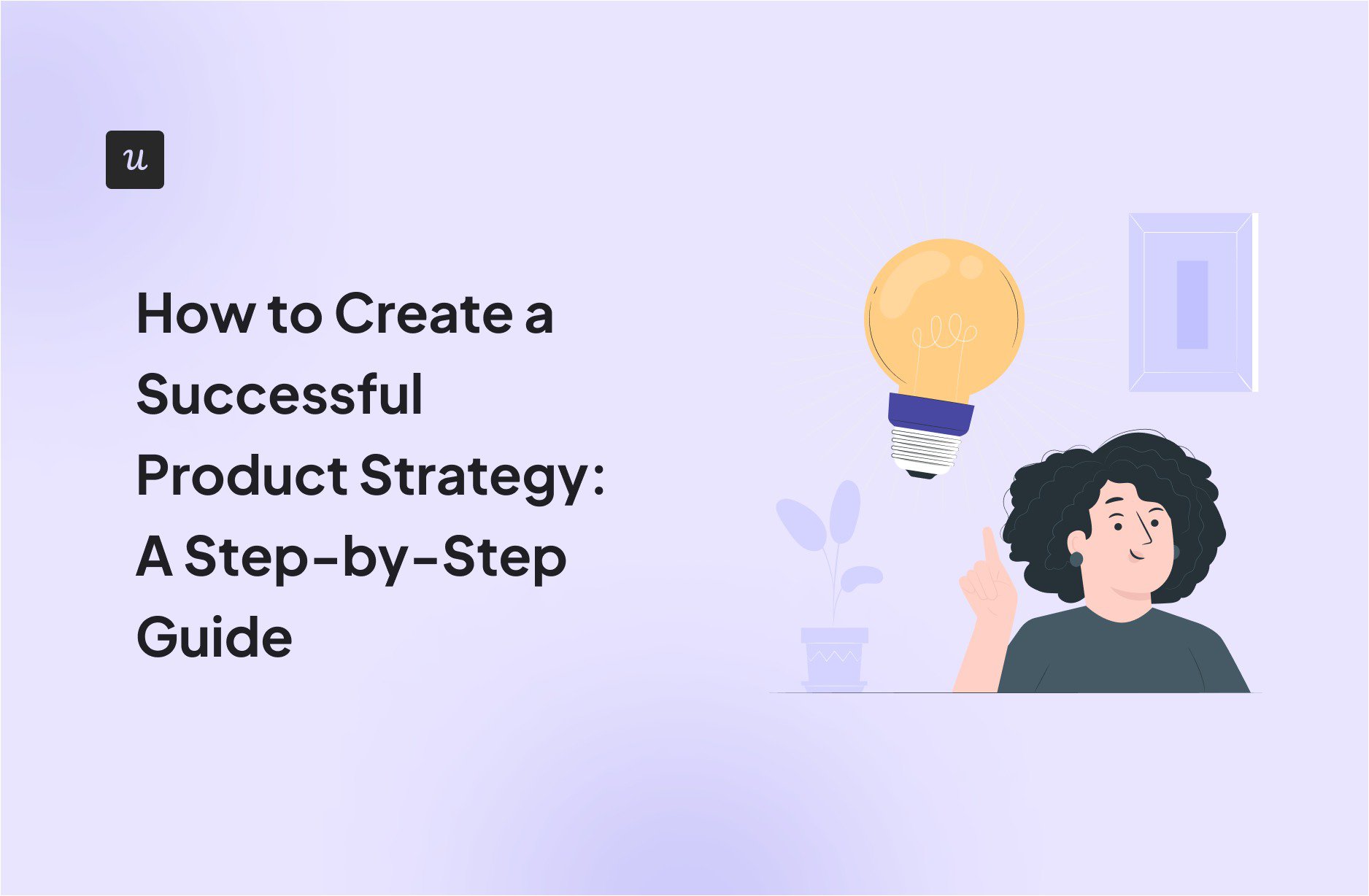
Try Userpilot Now
See Why 1,000+ Teams Choose Userpilot

What is a product strategy?
A product strategy, or product development strategy, is a high-level plan defining product goals and explaining how to support them throughout the product’s lifecycle. It’s informed by product vision and provides details on who the target customers are and how the product will benefit them.
‘Product strategy’ can also be an umbrella term for various strategy types:
- Quality strategy: you aspire to build a product whose quality surpasses competitors.
- Cost strategy: you deliver the most valuable product at the lowest cost possible.
- Focus strategy: you build a personalized product catering to a select group of users.
- Service strategy: relies on quality customer service to drive product growth.
- Differentiation strategy: you build a product that offers a unique experience or features.
The product manager is in charge of creating the product strategy in collaboration with other stakeholders. This includes senior leadership, who is responsible for company vision, mission, and product positioning, and cross-functional teams who provide bottom-up input and implement the strategy.

Product strategy vs product roadmap vs product backlog
Product strategy is more general than the product roadmap and product backlog.
Strategy is the overarching plan. It outlines product goals but isn’t very specific on how to deliver them.
The product roadmap details how the strategy is implemented. It includes high-level deadlines, key milestones, and major features to be developed.
The backlog is a list of tasks and features. It consists of specific items necessary to develop, improve, and maintain the product, prioritized based on their importance and alignment with the roadmap and strategy.
Why are product strategies important?
A well-defined strategy helps SaaS teams in a few ways:
- First, it guides product development and ensures it’s aligned with the product vision and organizational goals.
- It also improves decision-making by providing a clear framework for evaluating choices. For example, it can help prioritize features to develop.
- It also improves communication between the marketing, sales, customer success, and product teams and ensures they all work together.
How to develop a well-defined product strategy?
Now that we know what product strategy is and how it fits into the goal-setting hierarchy, let’s go over the process of building one.
Step 1: Research your target market to identify untapped customer needs
The objective of market research is to understand the needs, wants, and pain points of your target audience. Especially those that other products don’t address or do it inadequately.
Popular market and customer research methods include:
- Online surveys – using tools like SurveyMonkey.
- Social media polls – leverage your X, Facebook, or LinkedIn following to validate your ideas.
- Interviews – with prospective customers; with tools like Hotjar, you can manage them easily online without the hassle of meeting in person.
- Focus groups – to gather insights from diverse user samples.
- Social media and online listening – tools like Brand24 or Answer the Public allow you to monitor what prospective customers may be interested in.
- Secondary research – for example, from industry reports or academic research.
- Competitive analysis – by studying competitors’ offerings and customer reviews, you can identify weaknesses to exploit.
💡Example of customer needs
Userpilot has recently invested a lot of effort into developing its analytics capabilities.
Why?
Because none of the major competitors offered similar features, their users had to rely on 3rd party solutions. The only competitor that offered solid analytics, Pendo, isn’t very competitively priced.
Step 2: Define your product vision
A product vision is a statement that reflects the overall company mission and outlines what you want to achieve with the product in the long run: the problems you want to solve and how to stand out from competitors.
A good product vision should be clear and inspiring. Aspirational but attainable. It should provide the overall direction but not be too detailed so that it doesn’t stifle innovation.
Here’s a template you can use to create yours:
For [the target customer], who [the need], the [product] is a [product category] that [unique selling points]. Unlike [competitors/alternative solutions], our product [key differentiating factors].
💡Example of a product vision
Slack’s product vision is ‘To make work life simpler, more pleasant, and more productive.’
This statement outlines the benefits of the product to its users. However, it doesn’t go into detail on how to achieve this.
Why?
Because there could be different ways to realize the overarching goals, especially as technology or market needs evolve over time.
Step 3: Define measurable product goals
Having created the product vision statement, define more granular product goals.
These need to be specific and measurable so that you can easily measure progress. Not sure how to go about it?
Use a goal-setting framework. Like SMART.
SMART is an acronym for:
- S – specific (e.g., improve user activation rate).
- M – measurable (e.g., by 47%).
- A – achievable (it’s achievable – Attention Insight managed it when they implemented Userpilot).
- R – relevant.
- T – time-bound. (e.g., within 6 months).
Other popular frameworks include OKR, BHAG, and Lock and Latham’s 5 principles.

💡Examples of product goals
- Increase NPS by 5 by the end of the year.
- Launch feature X by the end of Q2.
- Improve product adoption rate by 17% by the of July.
If your goal is to improve product metrics, make sure to check Userpilot’s product metrics benchmark report 2024 for some interesting insights.
Here is a sneak peek:

Step 4: Create your product roadmap with initiatives
Initiatives are specific projects that help you achieve your goals and realize your product vision.
They break down the work that needs to be done into smaller and more manageable areas or themes.
Initiatives are broader than individual features or tasks and often span multiple phases of the product development lifecycle. You could say they’re a kind of bridge between your goals and outputs.
When creating initiatives and adding them to roadmaps, involve all stakeholders. For shared understanding and to secure their buy-in. This includes communicating some of them to the public.
Next, assess the interdependencies between initiatives and prioritize them.
While the roadmap includes a timeline, avoid committing to specific deadlines. If you’ve been involved in product development for a while, you know how difficult it is to estimate delivery times accurately.
Detailed deadlines put unnecessary pressure and undermine the stakeholders’ confidence when you get them wrong. Talking about quarters rather than months is way more productive.
💡Examples of initiatives
Here are examples of product initiatives for one of the goals above (increase NPS by 5 by the end of the year):
- Simplifying the onboarding process to reduce user friction and improve initial user impressions.
- Implementing 24/7 live chat support and expanding the knowledge base with detailed, easy-to-follow guides.
- Introducing in-app surveys and feedback forms to gather real-time user input and quickly implement improvements.
Step 5: Develop the right offering
The time has come to put all you’ve learned so far to work and build your product.
A successful product offers:
- Functionality that enables users to complete their tasks. This includes the core features as well as premium ones.
- Add-ons – complementary capabilities available in addition to the main product – at extra cost.
- Transparent and competitive pricing plans that enable users to experience the product value.
- Integrations with other products that expand product functionality and enable customers to seamlessly embed it in their workflows.
💡Examples of offerings
Intuit Quickbooks is an accounting suite for businesses and accountants. It offers a set of features like sending invoices and preparing tax returns.
In addition to core features, it offers add-ons, like payroll support.
Quickbooks offers 5 pricing plans, including dedicated ones for self-employed and limited companies. They all include discounts for the first 6 months, making it more attractive than its competitors.
The tool offers multiple integrations. For example, you can link it to e-commerce platforms and marketplaces like Shopify and Amazon. And thanks to the partnership with the UK’s HMRC, you can use it to submit tax returns directly.
Step 6: Gather feedback from target audience
Is your product strategy working? Hopefully. But the odds are that the initial strategy has room for improvement.
To identify opportunities, collect customer feedback.
While we mention feedback collection as the penultimate step in the process, this is something that you should be doing throughout the product development process. To validate ideas, evaluate prototypes, beta test features, and improve their performance.
💡Examples of feedback collection methods
Many of the market research methods, like customer interviews and focus groups above, work at this stage as well.
However, once you have a working product in place, you may also conduct usability testing or run in-app surveys.

The latter allows you to reach active users as they’re engaging with the product for more accurate and valid insights.
In fact, with Userpilot’s new mobile features, users can now trigger existing and new NPS surveys directly within their mobile apps, effortlessly gathering valuable user insights on-the-go.
In addition, you can collect passive feedback and feature requests via a feedback widget.
Step 7: Make evidence-driven decisions from customer insights
In addition to user feedback, use product analytics to inform your product strategy.
By tracking product KPIs and analyzing user in-app behavior, you get objective insights into the aspects of your product that require further optimization.
💡Examples of product decisions
- By tracking feature usage, you can identify the most valuable features. Ones that you need to develop and promote. At the same time, you can identify features that haven’t got much traction that you may need to sunset.
- Feature usage data can also help you diagnose issues with your onboarding process. For example, if users don’t adopt features vital to their use cases, it’s a sign that onboarding underdelivers.
- To understand why onboarding fails at driving feature activation and adoption, you can use funnel and path analysis. That’s how you find the touchpoints where users experience friction and drop-off.
Examples of successful product strategies
Let’s wrap up with a couple of examples of SaaS companies with successful product strategies.
Zoom
Zoom is the go-to video conferencing platform that dominated the market during the COVID-19 pandemic.
Its product vision statement is ‘To make video communication frictionless’.
What features and strategies do they use to implement it?
- A simple and intuitive user interface that makes it easy for users to manage and participate in meetings.
- Reliable HD video and audio connections with low latency.
- Cross-platform support, so users can use it on the go.
- Collaboration features, like Screen sharing, Whiteboards, Breakout rooms, Clips, and Notes.
- A marketplace with 2400+ apps and integrations, including tools like Calendly or Miro. To improve productivity and efficiency.

LinkedIn is a social media platform for professionals and businesses. Its product vision is ‘to create economic opportunity for every member of the global workforce.’
How do they implement it?
- It allows users to connect with colleagues, industry experts, and potential employers and enables them to showcase their expertise, establish credibility, and build professional relationships.
- It provides a platform where users can search for job opportunities and apply for available posts, regardless of where they’re located.
- The platform offers an extensive library of courses, allowing users to develop new skills. They come with certificates that can enhance one’s profile and make them more employable.

Conclusion
A product strategy helps product teams translate product vision into tangible and actionable goals, initiatives, and processes. It guides the product development efforts to ensure that they are aligned with genuine user needs – and with organizational goals.
If you’d like to learn how Userpilot can help you inform and implement your product strategy, book the demo!











